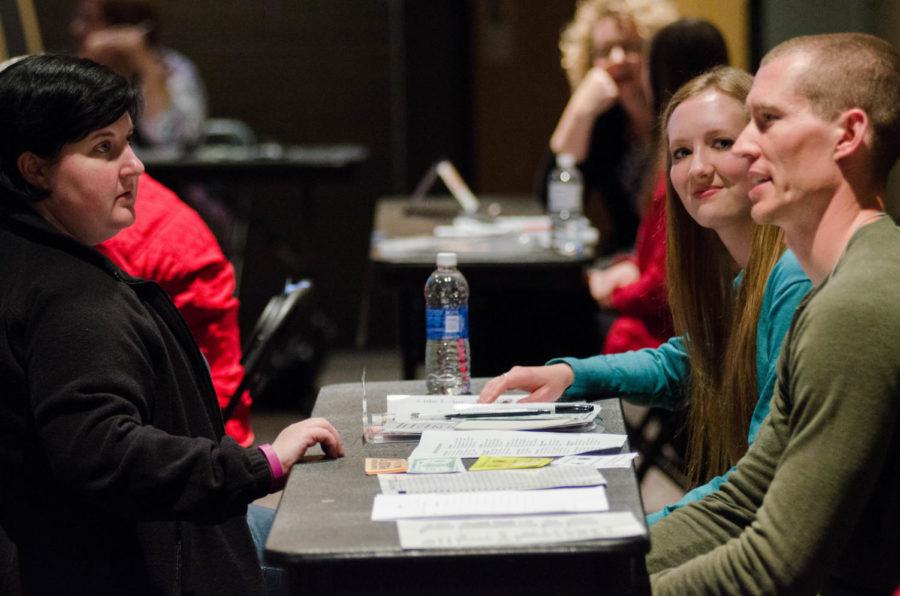Poverty simulation gives community members new perspective
Volunteers represent a child care center and inter-faith services at a poverty simulation at Cornerstone Church. The event was sponsored by Leadership Ames with the help of the Ames Community School District.
April 10, 2015
Ames residents experienced what it was like to live in poverty during a simulation Thursday night.
Small clusters of chairs were arranged in groups in a small, dimly lit auditorium in the Cornerstone Church of Ames, where local residents filed in and awaited the start of the activities at the Community Action Poverty Simulation.
“Do not treat this simulation like a game,” was the repeated instruction from panelists.
The attendees were arranged in groups from one person to six people. These “families” were then given a large envelope with transportation cards, Social Security information, bank accounts and other essential information.
Each participant was given an alias to use for the simulation. Everybody had a card around their neck that signified name and age. The participants were instructed to act as if they were their alias in the situation they were given.
The simulation lasted for one hour, which was divided into four 15-minute “weeks.” Surrounding the groups were several tables that acted as businesses and resources for the families.
The services available included a social services business, a bank, a community action agency, a school, interface services, a childcare center, a drug store, a clinic, workplaces, a payday loan store, a police department and pawn shop.
The families could only go to these places if they had the proper transport cards, and were able to use the available services only during “weekdays,” as all businesses closed on the weekends.
“I waited in the social services line for two days before I was helped,” said one woman, when administrators asked what had gone poorly in their simulation.
A man also said the experience was stressful but he and other “co-workers” banded together and gave emotional support, which helped.
During the four-week simulation, events such as random good or bad fortune would befall families, which was meant to mimic real circumstances such as accidents and good fortune.
As the four weeks passed, people began to run low on resources and dealt with the unexpected good or bad news. During week three, it was announced that the local school district was on holiday and kids were to stay home, meaning more money had to go into feeding the children that week.
Participants had several thoughts on the simulation.
“I know this event was aimed toward Ames community leaders,” said Jessica Gookin, senior in women’s studies.
Gookin said it was good to target local residents with some power to help the homeless and hungry.
Both Gookin and Ellie Havlik, senior in psychology, were in charge of the “social services” table during the activity.
“I think [the simulation] is really important to raise awareness around homelessness and around poverty,” Havlik said.
Havlik believed the activity also helped build community relationships. Many residents from local communities also participated.
“Since I lived in Chicago in the mid-’80s and saw poverty firsthand, I’ve been sensitive to the reality of poverty,” said Janis Pyle, Nevada resident and member of the Story County Housing Coordinating Board.
Pyle was concerned that many residents do not realize how many of their neighbors are struggling with homelessness and hunger.
When the simulation ended, the administrators put everyone in a circle around the room. Participants were then asked to stand for affirmation or remain seated in response to questions.
The event managers learned that many people with medical conditions did not go to a doctor for treatment, in order to save money. It was also shown that many people banded together, either with their neighbors or their co-workers, to make the struggle a little easier.
“It was really stressful, really overwhelming,” said Brian Phillips, a management analyst at the Ames City Manager’s Office.
He said he couldn’t imagine living like people in poverty had to live every day.
Phillips was in a family of four, which meant the resources were more divided than in a family of one or two people, potentially causing more stress.
“I think it’s been an outstanding afternoon,” said Anne Owens, executive director of the Volunteer Center of Story County and event manager.
Owens said she was proud of the number of people who came, which she said was between 50 and 70. The Community Action Poverty Simulation was sponsored by Youth and Shelter Services and the City of Ames Chamber of Commerce.
Owens also said she was proud of the Ames community, saying they were good people, and had the resources to help those community members who are homeless and hungry.
“Lots of eyes get opened from these events,” Owens said.

















